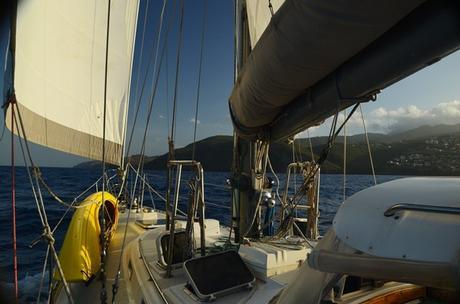
This post comes from Jamie, one in a series where he shares his knowledge as a tenured sailmaker. For more about Jamie’s experience in the field, see Sailmaker SAYS!.
Hey sailmaker. Tell me about luff tension. Hey dude, this isn’t Dear Abby. I won’t cover love tension or any other emotional instability you may have… Wait, what? I said lufffff tension, not luvvvvv tension you baf… Ohhh, why didn’t you say so? Okay, now that we’ve learned to annunciate, what’s you lufffff tension issue? With my mainsail, it’s easy to tell when the luff is under tensioned, but I’m not sure if I tension it enough or too much, you know?
Grey Matters
Luff: The leading or front edge of a sail.Luff tension: force exerted along the luff (vertically) mainly by the halyard; and also cunningham if rigged.
Cunningham: Block and tackle used to adjust mainsail luff tension. Lower end is attached to the mast just above the deck. The upper end has a hook to attach to a ring just above about 15” (38cm) above the tack. The purchase ratio is commonly 4:1.
When you hoist your mainsail, how do you set luff tension? Well… When the sail sags between luff slides and there are horizontal wrinkles it’s under tensioned. So I crank up the halyard until wrinkles and sag are gone. Perfect! No more winkles and sag. You’re like a plastic surgeon with a blade, easy! No. No, because then the wind changes. It picks up and the wrinkles and sag return. Or wind drops and the luff looks like… like a celebrity with a perma-smile from too many trips to the surgeon.

At left, under tensioned luff; at right, slightly over tensioned; notice the knuckle in the luff near the head.
Ah, okay, you’re a Polyester suit kinda guy, right? What? You know, Dacron sails and Polyester halyards to match? Christ, I thought you were going Dear Abby on me. Yes, Dacron main and pretty sure it’s a Polyester halyard. Well, Dacron is Polyester, and stretchy. So when wind increases, both halyard and sail stretch to present the wrinkle and sag show. Change the halyard to high modulus, low stretch line to cut the stretch by half. What line? Vectran doublebraid is best; or Dyneema/Spectra doublebraid is good, but has a little creep unless it’s high grade Dyneema. This will stop wrinkles and sag? No, but because halyard and mainsail as a whole will have less stretch, it’ll take more wind force before wrinkles and sag appear.

Perfect luff tension!
And when they do? If sailing upwind then you need more tension; downwind isn’t as big a deal, but it’s nice to add just enough tension to take the sag out. On a cruising boat, you don’t need a cunningham. Just winch the halyard up a little. But sometimes it’s hard to add halyard tension when the sail is full – it feels like something might break. If close hauled, ha ha, as if cruisers sail close hauled – but if so, just ease the mainsheet a little. Any other point of sail, force on the sail increases and decreases as the boat surges and slows. When surging, less sail force makes it easy to increase halyard tension. To feel this, apply moderate turning force to the winch handle. When surging the winch will turn easily. When slowed, the load increases again and turning the winch become difficult; so pause until the next surge. It’s the same technique for setting luff tension when you reef.
So what’s a cunningham? It’s a way to adjust luff tension from the bottom of the main, pulling downward. It’s a little easier than adjusting the halyard, but it’s more hardware and more holes in the mast. Since you must adjust halyard tension when reefing and unreefing anyway, why not keep things simple and use this technique for all luff adjustments. Cunningham makes sense for racing, to quickly fine-tune sail shape, but for cruising it’s how riggers exploit your cruising kitty. Riggers do that? Oh yes, they’re the absolute worst, after sailmakers of course.

Some tensioning needed…
Now about your Dacron mainsail. What you really need to eliminate stretch is a carbon fiber laminate beauty. It’ll impress your friends and work great if ever close hauled. But I’m not sure I can affor… Afford it – no way! I’m just making a point. Phew. Well, what about over tensioning the luff?
Lighter tension for lighter wind is okay – a little wrinkle and sag going on. And tension on with the wind increase, so the luff sailcloth is smooth. In moderate wind speed, say, to upper teens, over tensioning the luff will cause a vertical wrinkle parallel to the luff. It can stretch from tack to head. Pun? Yep.
In higher wind, it’s harder to tell if you’re over tensioning a Dacron sail. A vertical wrinkle won’t show, because higher loads just stretch the cloth. You may notice sail shape is further forward, looking like an abrupt shape change near to the mast. Sailmakers call it a knuckle, and this is no place for a knuckle. Got it?

Looking good!
In light air, a little wrinkle and sag is OK. In more wind, wrinkle and sag means it’s time for doctor to tweak things. if the sail’s tight enough to form a permanent vertical smile, then the doctor overworked the job. And if you have a cunningham, fine, but if not–skip it to foil the rigger.
Happy days, you nailed it Richie! Now, about that carbon mainsail…
Jamie’s always happy to answer questions about sails; just comment here or submit our contact form to get a message through, where ever we are. And hey, where is Totem? Find our current position and speed here!

